Reliability and sophistication in one device! Cast iron stoves for home
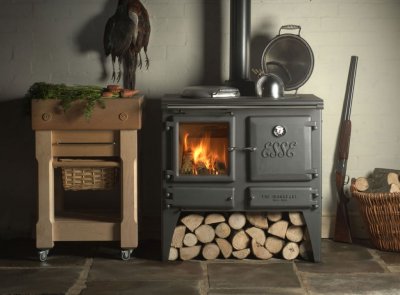
Cast iron stoves for the home are selected in accordance with certain requirements.
The main selection criteria are the ability to quickly heat a living space, the ability to give off heat for a long time, and the fire safety of the building.
For small houses an important requirement is – compact design dimensions, compatible with high efficiency. If the owners do not use the stove constantly and are in the house from time to time, the key requirement for the unit becomes its ability to quickly kindle in any weather at all times of the year.
Content
Types of cast iron stoves for home
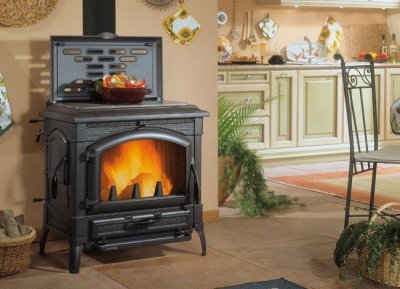
The body is usually cast in one piece, and individual cast iron parts, steel elements and refractory ceramics are attached to it with bolts.
Russian-made stoves are made of grey cast iron brands SCH-15 and SCH-20Foreign developers use materials with similar technical characteristics.
According to their functional purpose, there are three types of cast iron stoves:
- heating;
- cooking and heating;
- stoves-fireplaces.
For heating
They are intended exclusively for heating the home and come in different sizes and shapes. According to design, there are:
- single-chamber;
- channel;
- long burning.
Inside the body of a single-chamber stove divided into a combustion chamber And ash-pit. The width of the opening through which combustion air enters is regulated by opening the ash pan. A steel pull-out drawer is inserted into the ash pan, which facilitates the process of ash removal.
Attached to the firebox of the channel furnace 1-2 steel plates, forming smoke channels (so that the hot combustion gases are retained there until combustion). To prevent the floor from overheating, the body is installed on legs.
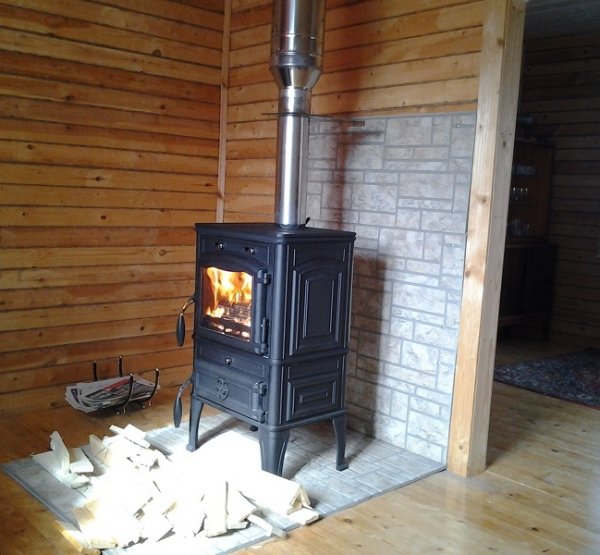
Photo 1. Cast iron wood stove designed for heating a room. Has one firebox and a ash pit.
Cast iron stoves designed for long-term burning are loaded with a large amount of fuel (75% of the firebox volume). The air supply is regulated by special dispensers in the middle and upper parts of the body.
Reference. Many home heating stoves do not have a horizontal surface where you can cook food. There are models with a small platform, on which a teapot or saucepan is placed.
Cooking and heating
They come in different sizes and are designed for rooms of different sizes. from 25 to 150 square metersWhat they have in common is the presence of a hob.
The hob can be:
- solid;
- with holes-burners, which are covered with rings and disks.
In addition to the stove, the body also has a built-in oven. Under the firebox there is a ash pit through which air is supplied for combustion (the inflow is regulated by opening the ash pit door or special dampers in it) and an ash box. All cooking and heating stoves are channel stoves.
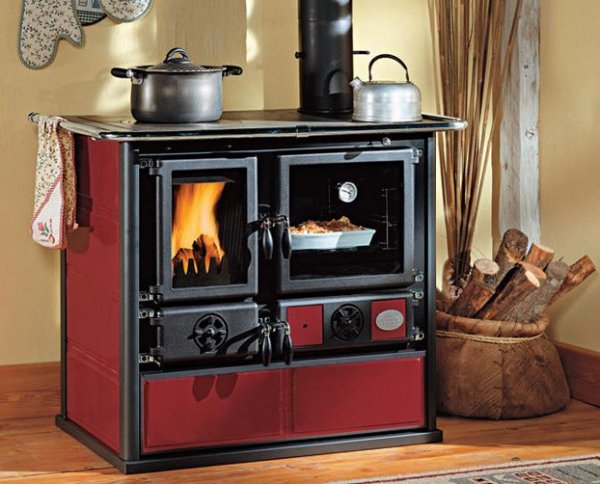
Photo 2. Cast iron cooking and heating stove. Has two burners and an oven.
The fireboxes of large cooking and heating factory furnaces have a heat-protective lining made of fireclay or crushed vermiculite. It can withstand temperatures up to 1200 degrees. The lining is removable and can be replaced. The doors of the furnaces (solid or equipped with a window made of heat-resistant glass) are made of cast iron. Sturdy legs are attached to the lower part of the body.
Wood burning stoves and fireplaces
Fireplace stoves, heating stoves and cooking and heating stoves differ in appearance. Many models have a low base, a high body and a large firebox, above which there is a straight chimney. creates sufficient thrust for intensive combustion of fuel.
Cast iron fireplaces made in factories often also combine elements of a stove. Many models have a ash pit with adjustable holes. This allows to extend the combustion time of fuel And get more heat from each portion of firewood.
On the top of the body of some models there is a platform on which you can heat up food. To protect the fireplace from burning out lined with fireclay bricks and vermiculite.
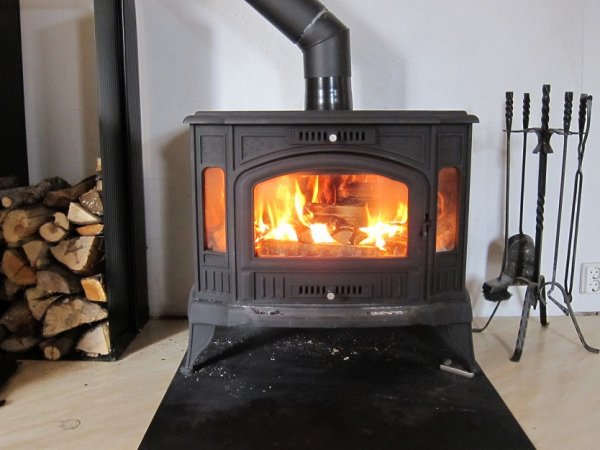
Photo 3. Cast iron wood-burning stove-fireplace. The door of the device is made of transparent heat-resistant glass, which allows you to admire the flame.
All factory cast iron fireplaces have a large firebox door into which a firebox is inserted. heat-resistant glass. Modern design, use in decoration of different styles make the device a decoration of the living room.
Important! The firebox of cast iron stoves and fireplaces from foreign manufacturers has a depth 18-20 cmIt is designed for burning short logs, pallets, peat briquettes, and wood chips.
Recommendations for choosing a cast iron stove
A home stove provides warmth, creates coziness and is part of the interior. When choosing a cast iron appliance, consider the following factors:
- region of residence;
- dimensions of the dwelling;
- purpose of the structure;
- interior design.
Cast iron structures are suitable for areas where winter temperatures do not fall below minus 10-12 degreesFor regions with more severe frosts, it is better to choose a brick stove.
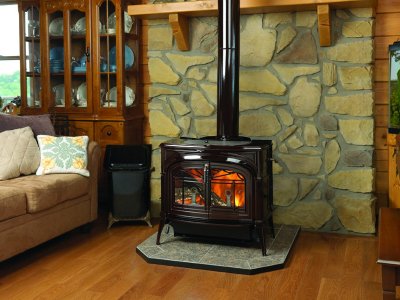
The size of the house also influences the choice of device. The larger the area of the home and the higher the ceilings, the more powerful the cast iron stove should be.
Powerful structures are not installed in small wooden houses. To heat them, it is enough to buy a compact stove.
Purpose of a cast iron stove depends on specific conditions. Owners can choose a fireplace stove, a cooking and heating stove, or a heating stove only, depending on their preferences and tastes. A fireplace is good for a living room, a heating stove can be installed in any room, and a cooking stove in the kitchen.
The design of the premises also influences the choice of the device. Factory cast iron stoves look beautiful and modern. You can find stoves made in the styles of high-tech, baroque, modern, Provence, which allows the devices to fit perfectly even into the most sophisticated interior.
Installing the device: step-by-step instructions
Before installing a cast iron stove of any kind carry out preparatory work, including the following stages:
- preparation of instruments;
- selection of installation location;
- preparation of the base;
- installation of a cast iron stove.
Preparing the tools
Construction and power tools are used during the installation process.
The list of tools and equipment includes:

- grinder and a set of discs;
- electric jigsaw;
- set of drills;
- plumb line;
- building level;
- ruler;
- square;
- chalk, pencil.
Equipment and tools are selected based on on installation conditions, wall materials, through which the chimney is discharged.
Selecting a location
The stove is placed in a convenient place for use. According to fire safety requirements, the distance between the heating device and flammable surfaces must be no less than:
- 120 cm — from the stove to the ceiling.
- 130 cm — from the firebox door and the stove body to the unprotected wall.
- The steel chimney pipe is fixed no closer than 30 cm from an unprotected wall. The places where the chimney exits through the wall itself are insulated with heat-resistant material. If the device is installed closer, the wall is protected with a screen made of brickwork, ceramic tiles, or other heat insulator.
Preparing the base
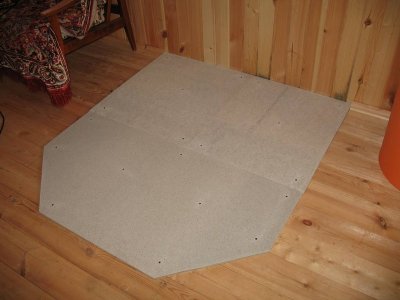
Heavy (weighing 300 kg or more) and a large cast iron stove is mounted on the base, not connected to the load-bearing walls of the building.
The foundation is built in advance, since the concrete must dry completely before the structure is installed.
A lightweight stove is installed on the floor, after first placing a sheet of metal or ceramic tile with a layer of thermal insulation underneath.
The foundation must extend beyond the perimeter of the heating structure by 60-70 cm.
Attention! For a wooden house, the weight of the stove is important - so that the floor does not deform, the load on it should not exceed 150 kg per square meter.
Construction of a rubble concrete foundation includes the following steps:
- A pit is dug in the ground (depth - not less than 50 cm).
- A layer of crushed stone is poured onto the bottom of the pit 18-20 cm.
- The crushed stone is filled with cement mortar.
- After the cement has dried, waterproofing is done in the pit using roofing felt, thick polyethylene or roofing felt.
- The joints of the waterproofing material are sealed with sealant.
- Wooden formwork is installed in the pit.
- Boulders and cobblestones are laid in an even layer on the bottom.
- The stone is filled with cement mortar.
- In a similar way, several layers of stone are laid and filled with cement.
- The foundation is left to dry completely. 10-12 days (in the cold season - up to 14-16 days).
- The horizontality of the foundation is checked using a building level and, if necessary, adjusted with cement mortar.
- A layer of bricks is laid on the finished foundation using mortar.
- After the solution has hardened, the foundation is ready for the installation of a heavy cast iron stove.
Installation process in a wooden house
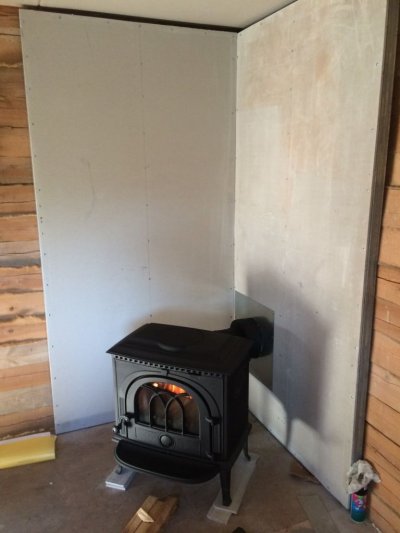
Let's consider the process of installing a cast iron stove in a small wooden house. The weight of the device is 40 kg, so no foundation is needed.
We prepare the base on the floor. A chimney with a length of 7 meters, consisting of steel pipes and sandwich pipes. The furnace is installed in 60 cm from the wall, in front of it remains 70 cm non-combustible base.
The chimney connection pipe is located on the top panel of the stove. Installation includes the following steps:
- The wall is being covered heat-insulating material (brickwork, ceramic tiles).
- Building a foundation for the stove made of non-combustible materials (brick, porous insulators with a steel sheet fixed on top, tiles).
- Legs are attached to the bottom of the stove.
- They are installed in the case blower box.
- The stove is placed on the base.
- Using a plumb line determine the location of the chimney passage through the ceiling. The plumb line should connect the center of the chimney pipe on the ceiling and the center of the stove chimney outlet.
- The center of the chimney is marked on the ceiling and a circle is drawn with a diameter of 9-10 cm exceeds the diameter of the chimney.
- A through hole is cut in the ceiling using a jigsaw.
- On the stove pipe the first section of the chimney is installed, it is attached to the wall using a clamp and brackets.
- The next pipe is placed on the first one, also attaching it with clamps and brackets to the wall along its entire length.
Reference. The pipes are connected overlapping, the upper one is put on the previous one. The joints are coated with sealant.
- Into the overlap a two-layer sandwich pipe is installed, is attached to the wall with a clamp and a bracket.
- The gap between the ceiling and the sandwich pipe filled with basalt wool, cover with foil on top.
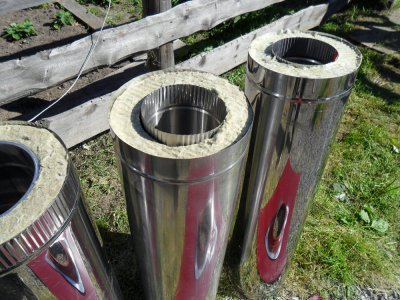
- A decorative panel with a cutout for the pipe is attached to the ceiling around the sandwich chimney.
- On a sandwich pipe put on a steel pipe, using a sealant in the connection. The pipe is extended in a similar manner and brought out above the roof.
- Made of sheet steel cut out a square section for the roof (with a hole for the pipe in the middle), put on the pipe.
- Then attach the skirt (cuff) made of rubber, glued with sealant.
- Top of the pipe protect with an umbrella.
The cutting is reinforced in different ways, depending on the material the roof is made of. For example, on a roof made of hewn boards, the cutting sheet is secured with screws with plastic washers that do not let water through.
Possible difficulties and problems when installing a cast iron stove
When cutting a hole for a chimney, it may turn out that the pipe intersects the supporting beams of the ceiling and the rafters of the roof. In this case, the stove is moved by 30-40 cm and make a new cut.
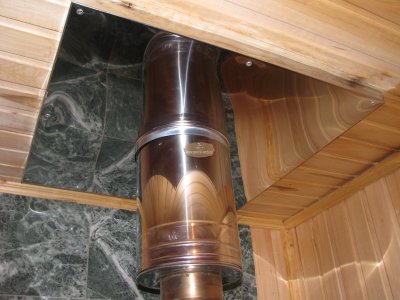
If, during a test run of the fireplace stove, it turns out that the room does not heat up to the desired temperature, the chimney configuration should be complicated. The more bends it has within the room, the warmer the house is.
During a test run it may turn out that the draft is poor. The situation is corrected, having extended the chimney, for its installation it is recommended to use pipes of the same diameter.
Low ceilings often overheat. The solution to the problem is thermal insulationFor this purpose, they use minierite layers, glass-magnesium sheets, asbestos slate, basalt wool, and ceramic tiles.
Sometimes during installation it turns out that the heating unit and chimney are too heavy for the floor and walls. Deformation of the house threatens a fire, in this case the heating structure dismantle and build a foundation that is not connected to the body and floorLighter pipes are used for the chimney.
Useful video
Watch the video, which demonstrates in detail the process of installing a cast iron stove and chimney in a wooden house.
How to Use a Home Wood Stove Properly and Safely
The stove must not be left unattended. When opening the door, coals and sparks should not fall beyond the firebox area.
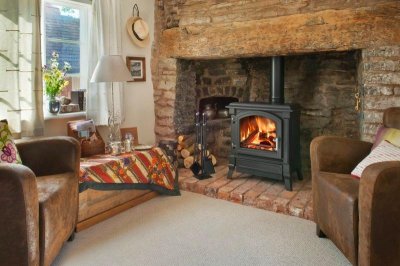
If there is a damper in the sandwich pipe, it do not close until the fuel has completely burned out. For combustion, use the fuel specified by the stove manufacturer.
Hot ash taken from the ash pan should not be left at home, as it releases deadly carbon monoxide.
Cast iron body and parts of the device do not like sudden changes in temperature. Do not allow cold water to come into contact with cast iron surfaces, as this may cause cracks. Do not move an already installed stove, as this will cause the chimney to become depressurized.







Comments
- oxygen supply controller to the furnace;
- lever for selecting air intake control;
There is also a forced ash release lever and an ash pan with a separate door. In the Nestor Martin S43 stove you can burn not only firewood, but briquettes and coal.